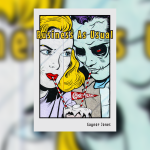A couple of years ago, I published a thread about rejections on Twitter. I thought it would be useful to dust this thread off, expand it, and publish it here as a mini reference guide. Hopefully, this provides some background to Ellipsis’ selection process, as well as offering reassurance to those who feel crappy whenever they receive one of those dreaded ‘Thanks, but no thanks’ emails.
Before we get to the main article, I’d like to state that I don’t send out rejection emails. The folders I use to handle Ellipsis submissions, are labelled ‘Pending’, ‘Accepted’ and ‘Declined’. ‘Rejected’ feels too harsh. It’s not only harsh but somewhat inaccurate, so I never actually reject, I ‘decline to publish’. Declining feels much nicer and more polite. I like nice and polite.
I take this thinking forward whenever I receive a ‘no thank you’ from a lit mag that I’ve submitted my own work to. They’re declining my words, not rejecting them. It seems to soften the blow, for me.
Below are a some of the main reasons your work may have been declined…
1. Rules, smooles
When you sent in you work you’ve ignored / misinterpreted / skimmed over, some, or all of our submission guidelines. If you have, your submission will stand out. It also feels like a waste of time, on both our parts, for me to straight-up decline your work based on something so basic. If you’re unsure of any of the points, drop me a DM or email and I’ll clarify them before you send anything in. I think it’s a fair trade to ask you to read our guidelines if you’d like me to read your submission. Most of the points in the guidelines are fairly common, some are specific to us, but they’re in place to make things easier for us both. Take a read of them here.
2. Her breasts were like… I think you get the idea
Occasionally, we receive work that is inappropriate / male gazing / sexist / homophobic / racist. While there (may be) places (probably, somewhere,) that will publish this type of work, a quick scan of our archive will reveal that Ellipsis isn’t one of them. Why waste your time sending it to us?
3. The floodgates have opened
Two or three times a year, usually after a competition has closed and the shortlist has been announced, we get inundated with work written for the same theme. I’m sure this happens in reverse when I release the author list for one of our print issues. The work not selected needs to find a home, but unfortunately, this work is now competing with several other pieces on the same theme. I always try to mix up the work I publish, to keep our readers on their toes and hopefully catch them with something they aren’t expecting, so I’m unlikely to accept multiple pieces on the same theme, especially in the same submission window. If you’ve just missed out on a longlist/shortlist, why not sit on the piece for a few weeks before sending it out?
4. Poetry
See, ‘1. Rules, smooles’ above.
5. There’s plenty of time
Your submission isn’t quite ready. I make this mistake with my own writing all the time. Once you’ve finished it. Put it aside for a few days and then read it again with a fresh pair of eyes. Pass it around to other authors, they may spot something that you’ve overlooked.
7. Returning authors
You’ve submitted to Ellipsis previously and have already been published, maybe several times. It’s going to get harder to be published each time because, not only are you fighting for space against the other submissions, you’re competing against yourself. I want to read something that is better or at least on par with your previous work.
8. It’s all subjective
It may seem like an obvious point to make, but it really is. Just because Ellipsis has declined your piece, doesn’t mean it needs work or isn’t up to scratch or should be shelved, never to see the light of day again. I prefer the films of the Cohen brothers, over the Marvel cinematic universe, Daniel Craig’s Bond over Sean Connery’s and a crime documentary over talent show TV. There’ll be many of you reading who’ll disagree with some or all of my choices. Reading submissions really isn’t any different.
I’ve published pieces that have been read 1,000s of times and some that have barely been read at all. But each piece was published because I enjoyed reading it. Sometimes it’s the pieces that I’m not expecting to strike a chord with readers that do, sometimes it’s not. There really is no hard and fast rule.
Did the piece take me somewhere I wasn’t expecting? Did I love the character / voice / theme / structure? Was I thinking about the piece hours, days, a week later? And, more importantly, do I think that Ellipsis readers will enjoy it too? Because that’s the question I really need answering whenever I’m selecting a piece for publication. If I’ve selected your work, then the answer to all of these questions is ‘yes’.
A couple of other things to consider…
Spulling mistacks
Don’t stress about the odd typo. I can barely type myself, so I’m not going to hold it against anyone who submits a piece containing minor errors.
Send it everywhere
I’d advise everyone to always sim sub their work. I try to get back to everyone within 7 days, to limit the time the piece is in limbo, but always send it out to as many publications as you can. I know that some lit mags ask you not to do this, but do it anyway, we need your words to fill our pages, without them, we don’t have a magazine. Don’t let anyone hold on to your work for months or even years before they reply to you, take back control.
Come one, come all
I never let your previous experience or publication list influence the selection process. Whether you’re a pushcart nominated author or it’s your first submission ever – whatever stage you’re at in your writing journey, you’re always welcome to submit to Ellipsis.
Form declines
I know a form decline email can be annoying, especially as it doesn’t specify why the piece isn’t being published. But I took the decision to use form emails due to having limited time. Ellipsis is run in my spare time, at weekends and before and after work. During any given week, I have an inbox of subs to read, site maintenance to perform, social media posts to generate and stock images to source, which is why I’ve streamlined the process when reading and replying as best I can to fit this all in.
I hope the email that you receive manages to encourage you to submit again, while at the same time appreciating the time you’ve taken to submit.
Finally, it’s worth rembering that if your work is being passed over, it’s because you’re actually submitting work for consideration. You can’t be accepted or declined if you don’t send your work out. So keep in the game, keep submitting. Shrug your shoulders and keep going. There are hundreds and hundreds of print and online publications and competitions on the look out for work. Bombard them. Make yourself a nuisance. If that doesn’t work, publish your work on a personal website or blog, or on sites such a WordPress and Medium. But just keep writing. There are people out there who really want and need to read your words.
…
Image: unsplash.com





